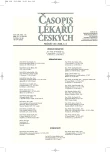Contemporary Alternatives in the Diagnostics and Therapy of Female Androgenetic Alopecia
Současné možnosti diagnostiky a léčby ženské androgenetické alopecie
Ženská androgenetická alopecie patří do skupiny nejizvících, difuzních, telogenních, hormonálně podmíněných alopecií s genetickou dispozicí. U androgenetické alopecie dochází k progresivní, androgeny zprostředkované miniaturizaci geneticky předurčených vlasových folikulů. Genetické faktory se uplatňují především u žen bez výskytu zvýšené koncentrace androgenů v séru. Patologicky zvýšená koncentrace sérových androgenů bývá při současných příznacích virilizace. Proces vypadávání vlasů začíná ve čtvrté dekádě života, někdy dříve. Vyskytuje se v postmenopauzálním období, po proběhlém těhotenství, při nasazení nebo vysazení perorální antikoncepce a u žen užívajících inhibitory aromatázy.
Klíčová slova:
ženská androgenetická alopecie, diagnostika, celková a místní léčba.
Authors:
H. Duchková
Authors‘ workplace:
Kožní oddělení – Masarykova nemocnice, Ústí nad Labem
Published in:
Čas. Lék. čes. 2006; 145: 189-194
Category:
Review Article
Overview
Female androgenetic alopecia belongs to the family of scar-less, diffuse, telogenic, hormonally determined alopecias with hereditary disposition. In the androgenetic alopecia, progressive, androgen mediated miniaturization of genetically predestined hair follicles develops. Genetic factors play a role namely in females without the higher serum androgen level. Pathologically high level of serum androgens is usually accompanied with signs of virilization. Hair dropping starts in the fourth decade or earlier. It occurs in the postmenopausal period, after a pregnancy, after the onset or termination of peroral contraception, in women treated by aromatase inhibitors.
Key words:
female androgenetic alopecia, diagnostics, general and local therapy.
Labels
Addictology Allergology and clinical immunology Angiology Audiology Clinical biochemistry Dermatology & STDs Paediatric gastroenterology Paediatric surgery Paediatric cardiology Paediatric neurology Paediatric ENT Paediatric psychiatry Paediatric rheumatology Diabetology Pharmacy Vascular surgery Pain management Dental HygienistArticle was published in
Journal of Czech Physicians

- Advances in the Treatment of Myasthenia Gravis on the Horizon
- What Effect Can Be Expected from Limosilactobacillus reuteri in Mucositis and Peri-Implantitis?
- Spasmolytic Effect of Metamizole
- Metamizole at a Glance and in Practice – Effective Non-Opioid Analgesic for All Ages
- Metamizole vs. Tramadol in Postoperative Analgesia
Most read in this issue
- Paranoid Syndrome, Paranoid Reaction, Paranoia
- Chronic Post-mastectomy Pain
- Percutaneous Sacroplasty in Sacral Insufficiency Fracture Treatment
- Development of Incidence of Post-dural Puncture Headache in Patients Undergoing Caesarean Section in Spinal Anaesthesia at the Department of Obstetrics and Gynecology in Olomouc during 2003–2004
